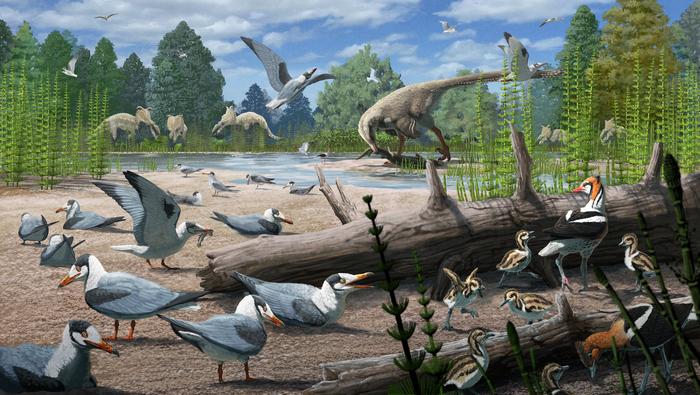In a groundbreaking discovery that redefines the timeline of avian evolution in polar environments, scientists have unveiled fossil evidence demonstrating that birds were nesting in the Arctic region as far back as 73 million years ago during the Late Cretaceous Period. This earliest-known documentation of polar bird nesting significantly predates previous estimates and sheds new light on the adaptability and persistence of early bird species amidst the harsh conditions of the ancient Arctic.
The study, published in the prestigious journal Science, challenges long-held assumptions about the geographic and temporal constraints of bird reproduction. Prior to this finding, the earliest known evidence of avian breeding in polar regions dated to approximately 47 million years ago, well after the catastrophic asteroid impact that extinguished a majority of Earth’s species at the end of the Cretaceous. The new research effectively pushes that timeline back by a remarkable 25 to 30 million years, foregrounding the polar Arctic as a critical and ancient nursery for birds.
Lauren Wilson, the lead author and doctoral student at Princeton University, whose master’s research at the University of Alaska Fairbanks (UAF) laid the foundation for this discovery, emphasizes the profound resilience of birds over geological time. “Birds have existed for 150 million years,” Wilson remarked. “For half of the time they have existed, they have been nesting in the Arctic.” The implication that avian species thrived in high-latitude environments during the age of dinosaurs invites a reevaluation of how these animals coped with extreme seasonal variations in light, temperature, and resource availability.
The research team conducted meticulous excavations at the Prince Creek Formation along the Colville River on Alaska’s North Slope, a location renowned for its rich assemblage of dinosaur fossils. Utilizing a comprehensive approach that involved collecting not only large, visible bones but also microscopic bone fragments and teeth through sediment screening, the team recovered over 50 avian fossil specimens. Among these were remains attributable to several bird groups, including diving birds analogous to modern loons, gull-like birds, and species bearing close resemblance to ducks and geese—all of which were breeding in the region over 73 million years ago.
One of the most remarkable aspects of the study is the preservation of baby bird bones, which are notoriously fragile and rarely found in the fossil record. The porosity and delicate structure of neonatal avian skeletal elements typically lead to their destruction over time. Yet, the Prince Creek Formation yielded multiple juvenile bones and teeth, offering unprecedented insights into the early life stages and reproductive behavior of Cretaceous birds. This discovery not only confirms breeding activity but also provides clues about nesting ecology under polar conditions.
Senior author Pat Druckenmiller, director of the University of Alaska Museum of the North and Wilson’s academic advisor, highlighted the significance of the collection, noting that it firmly "puts Alaska on the map for fossil birds," an area previously unrecognized as a major source of avian prehistoric data. He points out that the region’s fossils are invaluable for understanding how ancient species adapted to one of the planet’s most extreme environments—a stark contrast to the temperate or tropical locales typically associated with Cretaceous vertebrates.
The research team’s methodological rigor was instrumental in maximizing fossil recovery. Instead of focusing solely on large fossils, the scientists employed fine-screen sediment processing and microscopic examination to identify tiny, often overlooked specimens. This approach has proven extraordinarily fruitful, yielding new species discoveries and offering intricate details regarding the anatomy, physiology, and lifestyle of dinosaurs, birds, and mammals that co-inhabited the Arctic during the Cretaceous.
Not just important for paleontological taxonomy, the implications of this study extend to evolutionary biology and climatology. If the Arctic region supported diverse avian populations capable of reproduction during the Cretaceous, this suggests the existence of environmental conditions amenable to sustaining complex food webs through polar winters and extended darkness, an ecological complexity not previously appreciated for this time period.
Further analysis of the fossilized bones revealed characteristics consistent with Neornithes, the clade that encompasses all modern birds. Some skeletal features and the absence of true teeth in several specimens hint that the known fossils could represent some of the earliest modern bird relatives ever discovered. Presently, the earliest modern bird fossils are dated to about 69 million years ago. Confirmation of these 73-million-year-old fossils as Neornithes would recalibrate our understanding of bird evolution and geographic distribution.
Despite these clues, the researchers caution that more complete fossil remains, ideally partial or whole skeletons, are required to definitively assign these specimens to the modern bird lineage. The ongoing search for such fossils continues to be a paramount objective to illuminate this pivotal juncture in avian history.
This research was achieved through an extensive collaboration among scientists from numerous institutions, including the Bruce Museum, Princeton University, University of Reading, Florida State University, Royal Tyrrell Museum of Palaeontology, University of Alberta, University of Colorado Boulder, and Montana State University. It exemplifies the cooperative efforts necessary to unravel evolutionary mysteries through integrating paleontology, geology, and modern imaging technologies.
The study not only extends the known temporal range of polar bird nesting but also invites a broader reconsideration of how prehistoric wildlife interacted with their environments. By uncovering these ancient avian nurseries, the research illuminates a vital chapter in Earth’s biological heritage, underscoring the remarkable adaptability of birds both past and present.
Subject of Research: The earliest-known evidence of bird nesting in the Arctic during the Cretaceous Period
Article Title: Arctic bird nesting traces back to the Cretaceous
News Publication Date: 29-May-2025
Web References: DOI 10.1126/science.adt5189
Image Credits: Illustration by Gabriel Ugueto
Keywords: Cretaceous birds, Arctic nesting, fossil birds, Polar avian evolution, bird reproduction, Prince Creek Formation, Neornithes, bird fossils, dinosaur era birds, polar ecology




